Moving a Shed To Help With Reorganising the Garden
The original 1960s mini weighed in at about 600kg. A popular trick amongst rugby players was to pick up a friend's car and to move it into the middle of a flower bed or courtyard where it couldn't be driven out. It would take four rugby players to do this with one at each corner and I understand the car was more bounced than cleanly lifted.
A similar but more refined technique was used by Graham when moving a shed to reorganise his garden. Graham needed more storage space in his garden and wanted to build a new shed. However an existing shed was already in the area, but obstructing the new layout. The options open to Graham were to dismantle the existing building or to have a go at moving a shed in one piece.
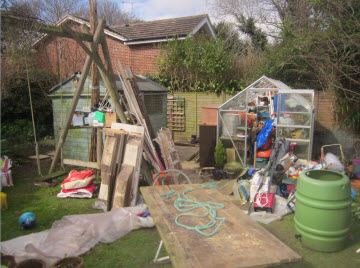 The Original Location of the Shed (clue its just behind the swing)
The Original Location of the Shed (clue its just behind the swing)
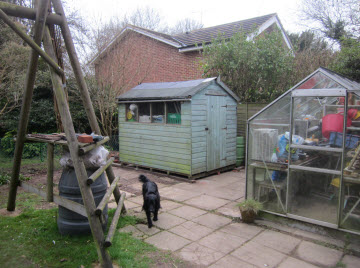 The Shed in its New Location (moved up against the fence and rotated 90 degrees)
The Shed in its New Location (moved up against the fence and rotated 90 degrees)
Which is easier, dismantling or moving a shed?
Graham's first step here was to look in a bit more detail at the two options;
Dismantling the shed would require taking the shed apart into 7 individual panels, moving them to the new location and then reassembling. It sounded simple until it was seen that the bolts that held the shed together were rusted up and would need to be individually cut. Also as the roof was in two parts the roofing felt would need to be removed, and then replaced. Neither of these were big problems but were they really necessary if the shed could be moved?
Moving a shed in one piece would require a bit more strategic planning. First of all was to determine the weight of the shed. For sheds such as this a rough allowance of 15 kg per m² gave an estimate of the all up weight of the empty building as 550kg. With four people lifting, one person at each corner, this works out at 140kg/person. This is quite a high figure but the lifting arrangement was changed so that a rope was passed under the shed and only one end of the shed lifted at a time. With two people on each end of the rope this would reduce the lift per person to a just about manageable 70kg per person for a short term lift. With this method each end of the shed would be lifted in turn and the log rollers slipped underneath to make the shed mobile.
The shed needed to be moved about 20 ft. and rotated through 90 degrees so some initial planning and ground work was required.
The preparation started by emptying the shed
Emptying the shed was critical to keeping the weight as low as possible.
The next step was to prepare the new site for the shed and to eliminate any humps and bumps in the track between the two locations.
Graham wondered whether he should install any temporary bracing to stop the building twisting while it was being moved. But as he looked closely there was only one loose fitting window and if the roof felt were to tear then it could be easily replaced.
As they were only moving a shed a short distance across flat ground Graham decided to give the bracing a miss. And work on the method of how the shed was to be moved.
The moving techniques was to be a combination of lift, roll and slide
The moving technique was to lift the shed at either end and place log rollers underneath so that the shed could be rolled across the ground into its new position. Lifting the shed at each end halved the weight to be lifted and so made the move possible.
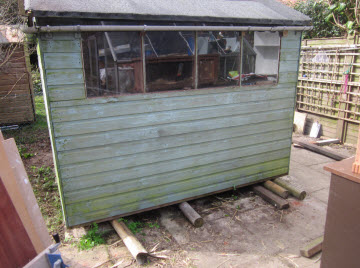 The Shed on Rollers Ready to Start Moving
The Shed on Rollers Ready to Start Moving
The lift was achieved by passing a rope under one end of the shed and four people lifting, two on each end of the rope (70 kg per person).
For this part of the move several 4 inch diameter peeled log rollers, left over from a previous project were used. The nylon rope was padded with cloth to soften the grip and enable the lifters to get a good hold on the building.
The final preparations included laying out the rollers in the path of the proposed move and checking that the floor bearers beneath the floor were in the right direction.
The move went according to plan
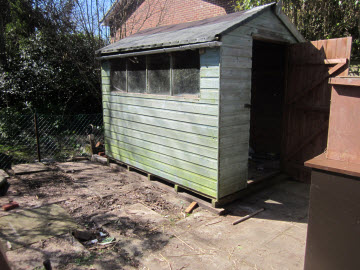 The on its New Timber Bearers in its Final Location against the fence
The on its New Timber Bearers in its Final Location against the fence
With one person on each corner of the shed the actual move took less than half an hour. The easy part of the move was lifting the shed on to the rollers and moving it towards the back fence. Once the shed was near the back fence it was turned through ninety degrees so that the side was parallel to the back fence. A small amount of fiddling around with removing the rollers and levelling the floor and voila the shed was ready to be filled with stuff.
The existing shed has been moved and the new shed built to reorganise the garden storage
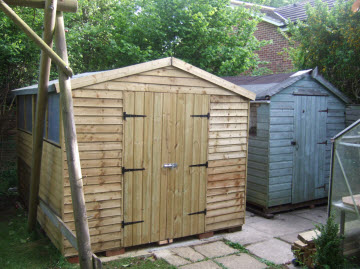 Old and New Shed Side by Side
Old and New Shed Side by Side
I have heard that that Grahams moving a shed experience went so well that has been telling his neighbours about the project. I have also heard that the ones that know about the 'mini moving pranks' are becoming worried that they might wake up one morning to find their family car in the middle of the flower bed or placed sideways across the drive!

Keep in touch with our monthly newsletter
Shed Building Monthly




